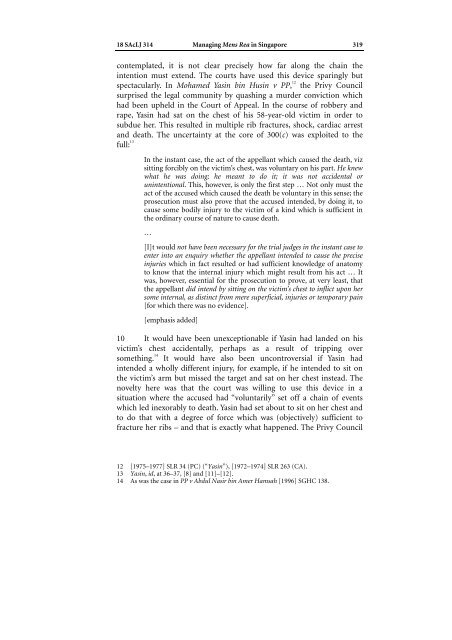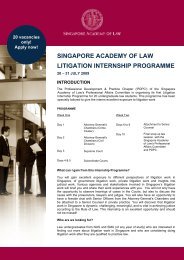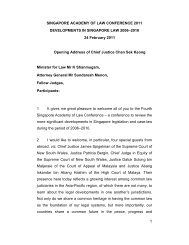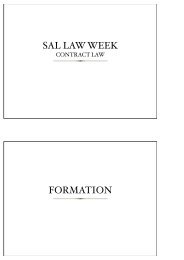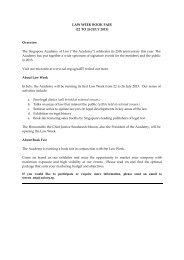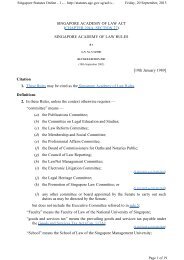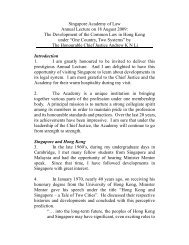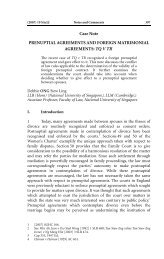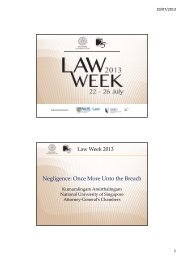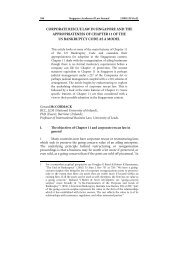2. Managing Mens Rea in Singapore - Singapore Academy of Law
2. Managing Mens Rea in Singapore - Singapore Academy of Law
2. Managing Mens Rea in Singapore - Singapore Academy of Law
You also want an ePaper? Increase the reach of your titles
YUMPU automatically turns print PDFs into web optimized ePapers that Google loves.
18 SAcLJ 314 <strong>Manag<strong>in</strong>g</strong> <strong>Mens</strong> <strong>Rea</strong> <strong>in</strong> S<strong>in</strong>gapore 319contemplated, it is not clear precisely how far along the cha<strong>in</strong> the<strong>in</strong>tention must extend. The courts have used this device spar<strong>in</strong>gly butspectacularly. In Mohamed Yas<strong>in</strong> b<strong>in</strong> Hus<strong>in</strong> v PP, 12the Privy Councilsurprised the legal community by quash<strong>in</strong>g a murder conviction whichhad been upheld <strong>in</strong> the Court <strong>of</strong> Appeal. In the course <strong>of</strong> robbery andrape, Yas<strong>in</strong> had sat on the chest <strong>of</strong> his 58-year-old victim <strong>in</strong> order tosubdue her. This resulted <strong>in</strong> multiple rib fractures, shock, cardiac arrestand death. The uncerta<strong>in</strong>ty at the core <strong>of</strong> 300(c) was exploited to thefull: 13In the <strong>in</strong>stant case, the act <strong>of</strong> the appellant which caused the death, vizsitt<strong>in</strong>g forcibly on the victim’s chest, was voluntary on his part. He knewwhat he was do<strong>in</strong>g; he meant to do it; it was not accidental orun<strong>in</strong>tentional. This, however, is only the first step … Not only must theact <strong>of</strong> the accused which caused the death be voluntary <strong>in</strong> this sense; theprosecution must also prove that the accused <strong>in</strong>tended, by do<strong>in</strong>g it, tocause some bodily <strong>in</strong>jury to the victim <strong>of</strong> a k<strong>in</strong>d which is sufficient <strong>in</strong>the ord<strong>in</strong>ary course <strong>of</strong> nature to cause death.…[I]t would not have been necessary for the trial judges <strong>in</strong> the <strong>in</strong>stant case toenter <strong>in</strong>to an enquiry whether the appellant <strong>in</strong>tended to cause the precise<strong>in</strong>juries which <strong>in</strong> fact resulted or had sufficient knowledge <strong>of</strong> anatomyto know that the <strong>in</strong>ternal <strong>in</strong>jury which might result from his act … Itwas, however, essential for the prosecution to prove, at very least, thatthe appellant did <strong>in</strong>tend by sitt<strong>in</strong>g on the victim’s chest to <strong>in</strong>flict upon hersome <strong>in</strong>ternal, as dist<strong>in</strong>ct from mere superficial, <strong>in</strong>juries or temporary pa<strong>in</strong>[for which there was no evidence].[emphasis added]10 It would have been unexceptionable if Yas<strong>in</strong> had landed on hisvictim’s chest accidentally, perhaps as a result <strong>of</strong> tripp<strong>in</strong>g oversometh<strong>in</strong>g. 14It would have also been uncontroversial if Yas<strong>in</strong> had<strong>in</strong>tended a wholly different <strong>in</strong>jury, for example, if he <strong>in</strong>tended to sit onthe victim’s arm but missed the target and sat on her chest <strong>in</strong>stead. Thenovelty here was that the court was will<strong>in</strong>g to use this device <strong>in</strong> asituation where the accused had “voluntarily” set <strong>of</strong>f a cha<strong>in</strong> <strong>of</strong> eventswhich led <strong>in</strong>exorably to death. Yas<strong>in</strong> had set about to sit on her chest andto do that with a degree <strong>of</strong> force which was (objectively) sufficient t<strong>of</strong>racture her ribs – and that is exactly what happened. The Privy Council12 [1975–1977] SLR 34 (PC) (“Yas<strong>in</strong>”), [1972–1974] SLR 263 (CA).13 Yas<strong>in</strong>, id, at 36–37, [8] and [11]–[12].14 As was the case <strong>in</strong> PP v Abdul Nasir b<strong>in</strong> Amer Hamsah [1996] SGHC 138.


